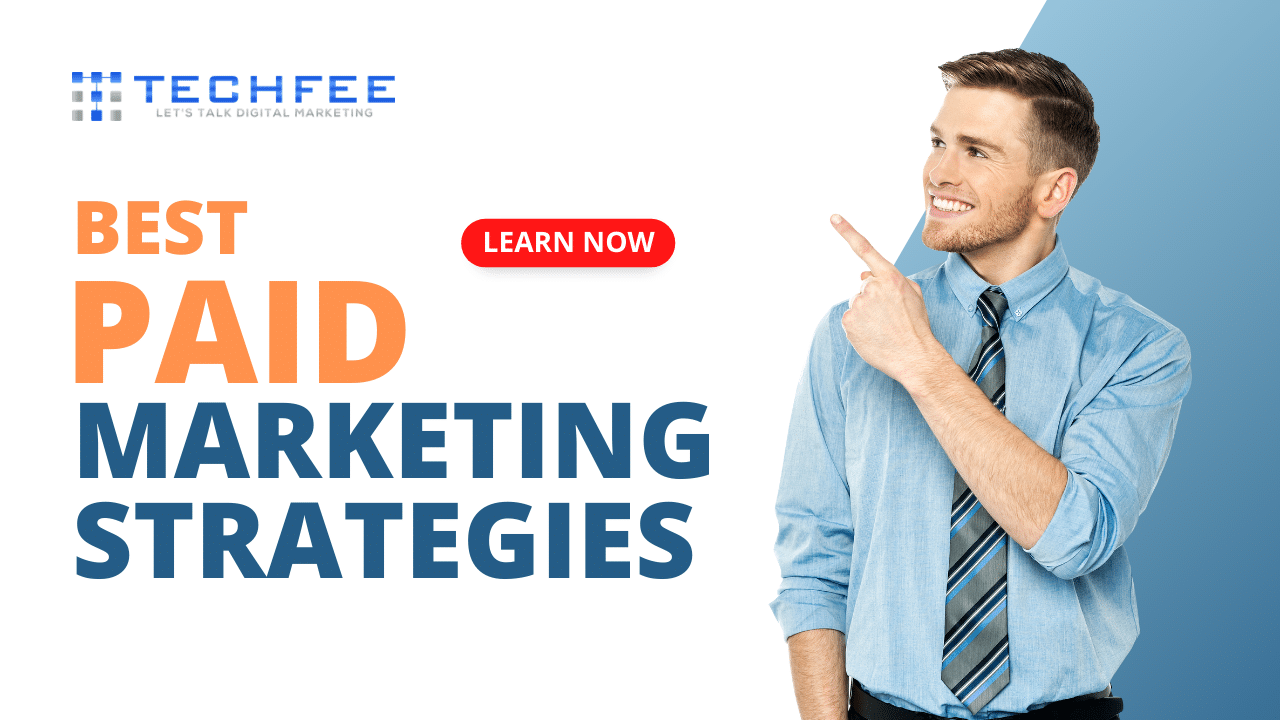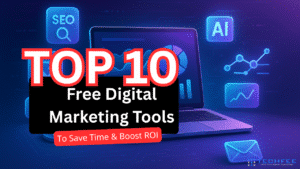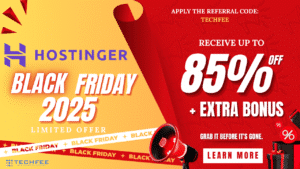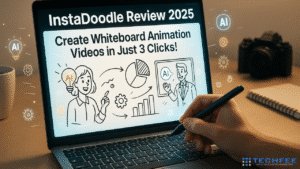Are you finding it challenging to connect with your target audience? Are you struggling to stand out in the fiercely competitive market? If so, paid marketing strategies could be the game-changer for your business needs.
In this article, we will browse the incredible power of paid marketing and how it can push your brand to new heights. Get ready to find the secrets to enhance your online presence and drive accurate, measurable results through these effective paid marketing tactics.
In essence, paid marketing involves advertising to promote your products or services, thinking of it as spotlighting your business in a crowded room.
With the right approach, your brand can truly shine like never before. Imagine engaging ad campaigns that target your ideal customers, driving traffic to your website, and converting leads into loyal customers – all made possible through paid marketing.
Throughout this article, we’ll dive into the most effective paid marketing channels and techniques, providing a comprehensive guide to success.
Discover how social media advertising can expand your brand’s reach, how pay-per-click campaigns generate instant traffic, and how influencer partnerships can skyrocket your credibility. Prepare to optimize your marketing budget and witness tangible results that leave your competitors envious.
So, without any further delay, let’s jump into the realm of paid marketing strategies and unlock the full potential of your business.
What is Paid Marketing?
Paid marketing, also called pay-per-click (PPC) advertising, is an integral part of digital marketing where businesses and advertisers invest in displaying their ads to a targeted audience. The primary focus is to attract potential customers and increase website traffic by paying a fee each time someone clicks on their ad.
This form of marketing is dominant on various online platforms, such as search engines and social media websites, allowing advertisers to bid on keywords and demographics relevant to their target audience. The beauty of paid marketing lies in its ability to provide instant visibility and measurable results, enabling businesses to accurately gauge their return on investment (ROI).
However, it necessitates continuous monitoring and optimization to ensure the best outcomes and cost-effectiveness. When executed strategically, paid marketing can significantly strengthen a company’s online presence, generate valuable leads, and ultimately increase sales and brand recognition, making it an indispensable component of any well-rounded digital marketing strategy.
Why Should Startups Focus on Paid Marketing?
Startups should place a strong priority on utilizing paid marketing as it brings on several compelling advantages:
1. Paid marketing is a quick and efficient tool to garner immediate visibility and reach a targeted audience. During the initial stages of a startup, establishing brand recognition is crucial, and paid advertising channels offer a way to swiftly capture the attention of potential customers actively seeking products or services like theirs.
2. It grants startups the flexibility to have complete control over their marketing budgets, allowing them to allocate resources based on valuable data-driven insights and adapt their strategies as necessary. This adaptability is essential for young businesses as they aim to optimize their spending and achieve the highest possible return on investment.
3. Paid marketing campaigns provide invaluable data and analytics that offer insights into customer behavior, preferences, and engagement levels, enabling startups to refine their marketing efforts and better understand their target market.
4. Paid marketing platforms offer a variety of ad formats, spanning from search ads to social media ads, video ads, and display ads, granting startups a diversified approach to connecting with their audiences across multiple channels.
5. In a fiercely competitive landscape, paid marketing serves as a great equalizer, enabling startups to stand out and gain an advantage against more established competitors through targeted messaging and innovative campaigns.
By effectively integrating paid marketing efforts with a solid product or service offering, startups can expedite their growth and lay a robust foundation for long-term success in the market.
Benefits of Paid Marketing
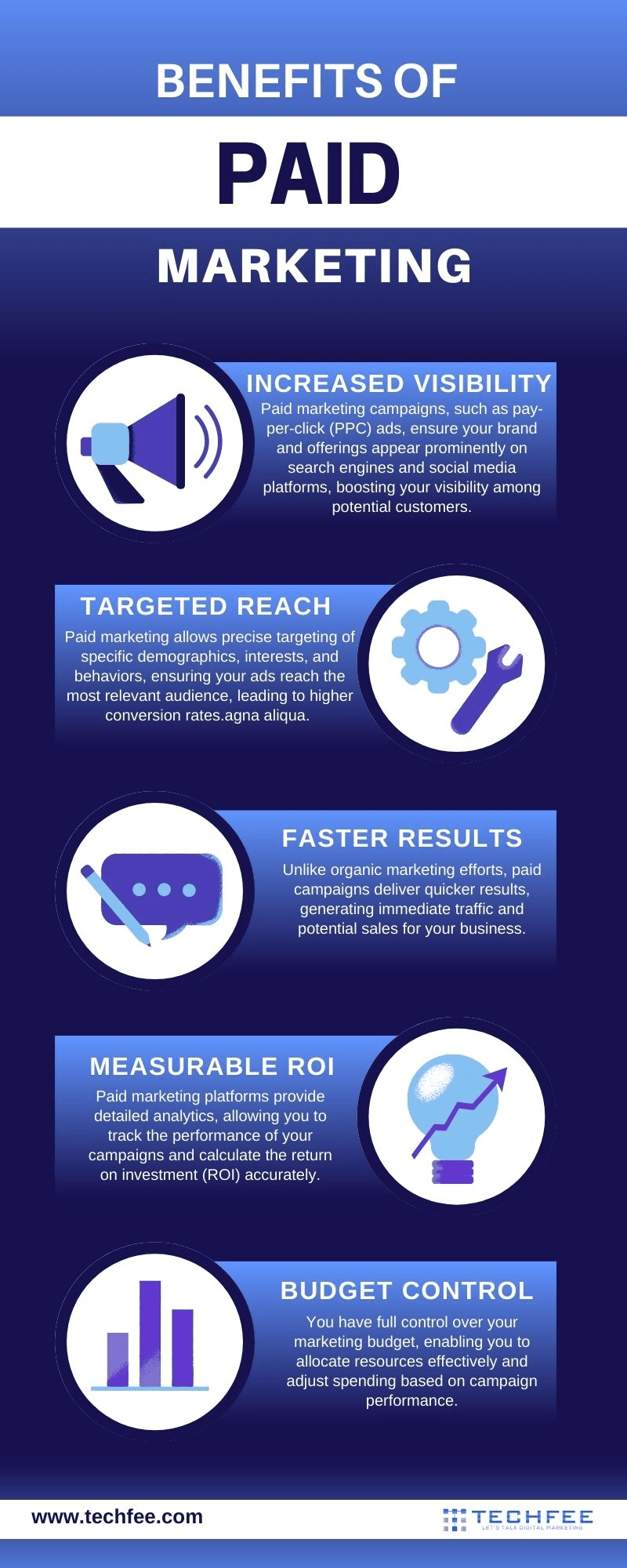
Organic vs. Paid Marketing
Organic and paid marketing present two avenues for any business to promote its products or services in the digital domain. Organic marketing employs unpaid strategies such as search engine optimization (SEO), content marketing, social media engagement, and community building to connect with the target audience genuinely. This approach emphasizes fostering lasting relationships, building brand loyalty, and encouraging word-of-mouth referrals over time.
Conversely, paid marketing entails investing resources in online advertising platforms to gain immediate visibility and drive traffic to the business. Pay-per-click (PPC) ads, display advertising, sponsored content, and social media ads are typical examples of paid marketing tactics.
This method can yield quick results and precisely target specific audiences based on demographics, interests, and behaviors, making it particularly beneficial for new ventures or time-sensitive campaigns.
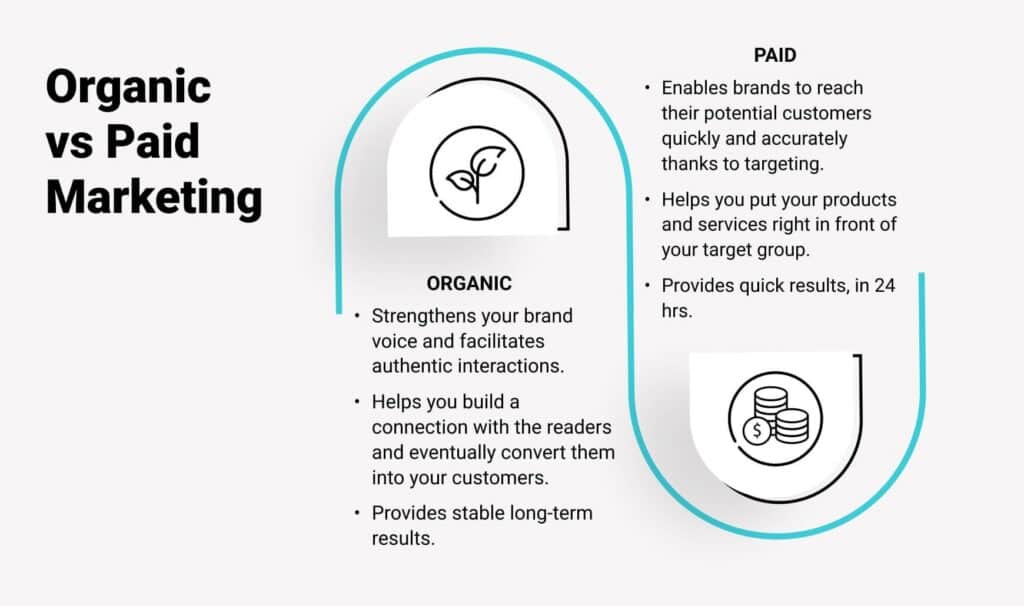
Businesses should consider their unique objectives, budget, and target audience to determine the most suitable approach. While organic marketing demands dedication and time to establish a robust online presence and organic reach, paid marketing can swiftly generate visibility but necessitates continuous investment for consistent results.
An effective marketing strategy might involve combining organic and paid methods, capitalizing on their strengths to maximize reach, engagement, and conversions.
Regularly evaluating the performance of each strategy and adapting tactics accordingly will be critical to a successful marketing campaign in the ever-evolving digital landscape.
The Best Paid Marketing Methods
Pay Per Click (PPC)
Pay-per-click (PPC) has established itself as a highly effective paid advertising strategy over the years, and its influence in the marketing realm continues to grow unabated.
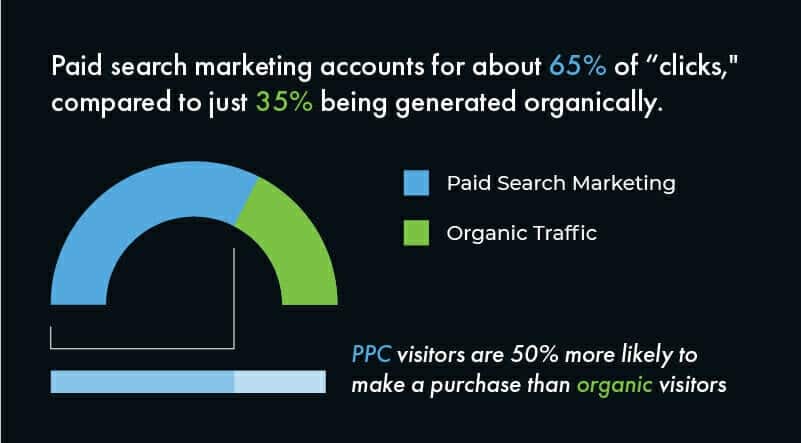
Approximately 65% of all “clicks” come from paid search marketing, surpassing the 35% generated organically.
Moreover, PPC visitors display a 50% higher likelihood of purchasing than organic visitors. These compelling statistics underscore the potential of pay-per-click advertising as a valuable investment for your marketing budget.
Social Media Ads
Over the past few years, the impact of posting ads on social media has skyrocketed, particularly with platforms like Facebook offering an array of paid marketing options. A relatively new feature called “Audience Insights” on Facebook has proven to be a game-changer for marketers.
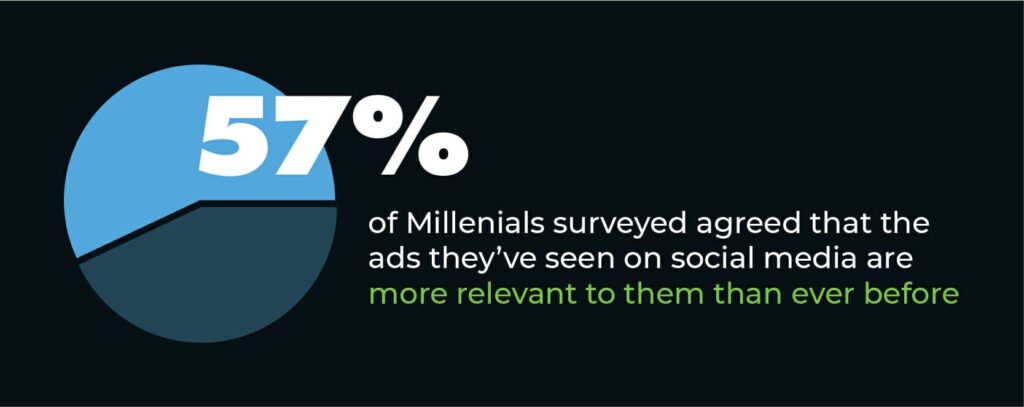
It allows them to precisely target their desired audience, gain valuable insights into their preferences, and create compelling ad content.
Advertising on social media is now recognized as one of the easiest and most effective ways to get your message across to your target audience, and social media users agree.
A survey found that 57% of Millennials believe that the ads they come across on social media are now more relevant to their interests than ever before.
Influencer Marketing
In the past few years, influencer marketing has emerged as an exceptionally potent form of paid advertising. Influencer marketing entails collaborating with a renowned figure in a particular industry, like a celebrity, to persuade your target audience to prefer your company or brand.
This approach proves particularly impactful on social media platforms and is an excellent substitute for traditional paid advertisements, which some customers have started blocking. Remarkably, as early as 2016, influencer marketing surpassed print marketing in terms of effectiveness for the first time.
Banner Ads
Banner ads, those small rectangular advertisements commonly seen along the top or sidebar web pages, have a long-standing presence dating back several decades. Nowadays, these banner ads have expanded beyond desktop devices and can be frequently encountered on mobile devices like smartphones and tablets.
Surprisingly, despite the emergence of various new paid online advertising strategies in recent years, banner ads have consistently proved to be highly effective. As of 2018, businesses were estimated to allocate nearly $25 million annually to invest in both desktop and mobile banner advertising combined.
Ad Retargeting
Ad retargeting or remarketing is an emerging paid advertising opportunity that has gained significant traction recently. This strategy involves utilizing cookies on a website to track users’ activities anonymously as they browse the internet.
By collecting this data, advertisers can display highly relevant ads to individual users. Remarketing or retargeting is especially effective for websites with high traffic volumes, ideally exceeding 5,000 monthly visitors. If your website meets this criterion, consider implementing this paid strategy to enhance your advertising efforts.
Affiliate Marketing
Affiliate marketing is a performance-based marketing strategy where businesses reward their affiliates for driving traffic to a website and generating sales or opt-ins.
Affiliates are paid whenever they bring a customer or lead to the client’s website. This marketing model comprises four key components: the merchant (the brand or retailer), the network, the publisher (the affiliate), and the customer.
Contextual Ads
Contextual ads are paid advertising on related web pages through an automated sponsored ad system. These ads can be text or image-based content designed to match the context of the page they appear on.
This method of online advertising has become increasingly popular on mobile sites, especially for targeting mobile visitors. Google Adsense, for example, has developed a specific ad format exclusively for mobile devices.
Floating Ads
Floating ads are a popular type of paid online advertising method. These ads are known as rich media web ads that blend seamlessly with the content of a webpage. They appear on the page that a user has requested or visited.
They can either be non-intrusive or disappear automatically after a set period, typically five to thirty seconds. The most basic floating ads appear on the webpage, either in full-screen size or a smaller rectangular window.
Popup and Pop-under Advertising
Popup ads and pop-under ads are two common paid online advertising methods. They are designed to capture email addresses, direct traffic to a particular website, or promote a product or service. These ads typically open in separate web browser windows to advertise.
Popup ads are generated using various techniques, and two standard methods are Cross-Site Scripting (XSS) and JavaScript. These techniques enable advertisers to create and display popups when users visit specific web pages or perform certain actions on a website.
Pop-under ads, on the other hand, behave differently. Instead of appearing right in front of the user’s main browser window like popups, they open discreetly behind it. Despite this difference, pop-under ads serve the same purposes as their popup counterparts: to capture user attention, promote offerings, and direct users to desired destinations.
Both popup and pop-under ads are forms of online advertising that marketers use to reach their target audience and achieve specific marketing objectives.
However, it’s worth noting that some users find these types of ads intrusive, and various web browsers and ad-blockers offer options to control or block them for a more pleasant browsing experience.
Steps to Create an Effective Paid Advertising Campaign
• Set Your Goals
To begin with, it is crucial to establish a SMART objective, which stands for Specific, Measurable, Attainable, Realistic/Relevant, and Time-bound.
For instance, let’s consider the objective of selling 1,000 gowns within a two-month timeframe with a budget of only $2,000.
Specific: The objective is to achieve sales for gowns.
Measurable: The target is to sell 1,000 gowns with a budget of $2,000, equating to an average cost of $2 per sale.
Achievable: This objective is attainable, aligning with our target market’s average clothing conversion rate of $2 per sale.
Relevant: The focus is on identifying and targeting the appropriate audience capable of purchasing this type of clothing.
Time-bound: The timeframe for accomplishing this campaign is two months.
Setting a clear goal is fundamental to fulfilling your purpose. Without a well-defined objective, a business may lack direction regarding how many sales are required to become a profitable startup.
This is why, in business, accountants and finance experts collaborate to develop achievable goals. Nevertheless, since startups may only sometimes have access to expert assistance, founders can set their plans to expedite the journey to profitability.
• Define Your Target Audience
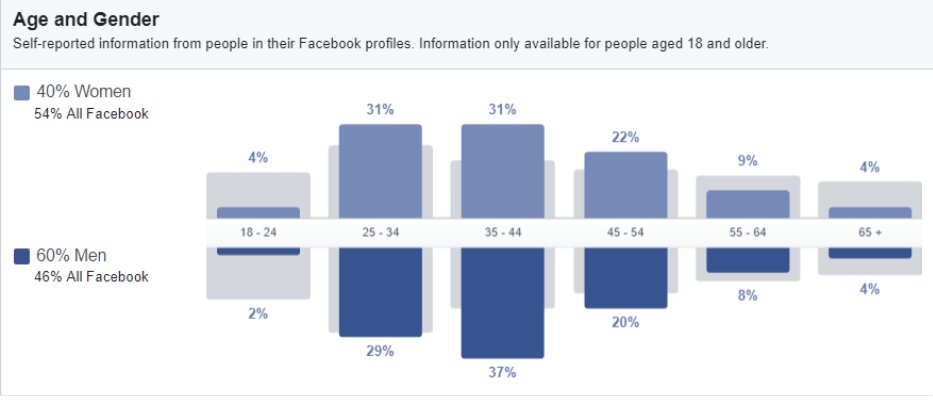
After defining your goal, the next step is identifying your target audience for effective product marketing.
Let’s revisit our goal: selling 1,000 gowns for $2,000, with a desired Cost Per Conversion (CPC) of $2.
The subsequent task involves finding a relevant audience to engage with our gown’s sales.
On most paid platforms, locating a similar audience through competitor page selection is convenient. For instance, we can target audiences interested in ‘Jovani,’ ‘Marchesa’s,’ ‘Needle & Thread,’ and related themes.
Additionally, conducting keyword searches like ‘online shoppers,’ ‘gowns,’ ‘fashion,’ ‘designer clothes,’ etc., can help identify potential audience segments.
Once the appropriate audience is chosen, the next step involves discovering platforms that host this type of audience.
• Choose The Correct Platform
The advantage lies in accessing the desired audience on social media platforms and search engines. However, we have decided to opt for Facebook as our primary medium due to its diverse range of audience segments, providing us ample opportunities for experimentation.
For those unfamiliar with paid platforms, kindly refer to the platform breakup table above, which contains a comprehensive list of platforms and the types of advertisements they support.
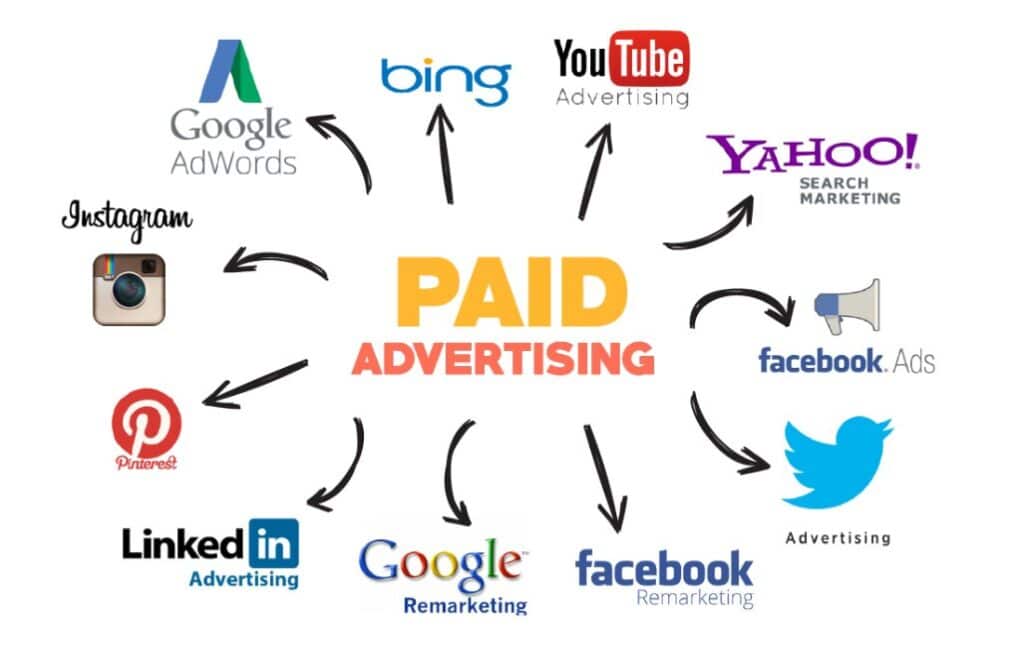
It is crucial to emphasize that identifying suitable marketing platforms is vital for small and large e-commerce stores. Choosing the wrong channels for marketing can lead to a significant drain on the budget for paid marketers, resulting in dire consequences, such as operational obstacles for startups and, in extreme cases, even bankruptcy.
Please note: Allocating a modest budget for testing various platforms is essential. Once you discover the optimal approach, you can scale your operations to capitalize on the most effective strategies.
• Use Organic Keyword Research
The content featured on your website should primarily cater to broader search terms not explicitly targeted by your text ads. Such searches necessitate an informative rather than an interactive approach, making it ideal for educating your audience through blog posts or other forms of content.
As mentioned in this article, another effective strategy is to launch an awareness campaign aimed at these broader keywords.
However, unless you include educational materials in your advertisements, it is generally more beneficial to approach these keywords from an SEO perspective rather than directly advertising for them.
• Use Long Tail Keywords
Opting for long-tail keywords represents the optimal approach to broaden your targeting efforts. These keywords boast higher specificity and ease of ranking while facing lesser competition. Consequently, you can attain improved search rankings and lower the cost per click. Moreover, their precision makes long-tail keywords more likely to convert leads into successful sales.
To illustrate, consider the scenario where you sell twinning dresses. An advertisement focused on the long-tail phrase “twinning dresses in California” would generate more impressions and leads at a lower cost than targeting the generic term “dresses.”
• Bid on Branded Keywords
One of the most significant mistakes brands make is bidding wars over highly competitive industry keywords. Such a practice can rapidly deplete their advertising budget. If you are a seller on platforms like Amazon or eBay, potential customers are likely searching for your products on Google.
The best approach to optimize your advertising strategy is to focus on bidding for branded keywords. For instance, a brand like Tommy Hilfiger should bid on terms such as “Tommy Hilfiger Footwear” or “Tommy Hilfiger + [specific product name].” By doing so, you can effectively target users with a solid intention to make a purchase.
These users might have discovered your products on Amazon but now wish to buy directly from your website. Alternatively, they may be interested in learning more about your brand story and the materials used in your products.
• Video is The Way to Go
Video content reigns supreme as the most captivating form of media available. It possesses the unique ability to convey a complete narrative within a concise timeframe, making it an ideal storytelling medium.
Additionally, the video boasts the highest return on investment in eCommerce advertising campaigns.
Major eCommerce brands capitalize on this power by incorporating videos into their promotional efforts across various platforms such as Facebook, Instagram, Pinterest, and marketplaces like Amazon.
An array of video types can be harnessed to achieve diverse marketing objectives:
- Narrate your brand’s compelling story,
- Present a mesmerizing display of your brand’s essential features,
- Leverage user-generated photos to enhance authenticity,
- Utilize impactful shots featuring influencers,
- Showcase satisfied customers using your products,
- Unveil the meticulous process behind crafting your products, and
- Highlight your brand’s involvement in charitable causes through donations or contributions.
Incorporating these various video formats into your marketing strategy can elevate your brand’s visibility and engagement, leaving a lasting impression on your audience.
• Retarget Using UGC And Influencer Content
Utilizing product reviews and recommendations is the most potent strategy to boost your product’s promotion. User-generated images hold the trust of 55% of consumers, surpassing all other advertising forms.
Furthermore, research reveals that 86% of women rely on social media for shopping suggestions.
Consider incorporating your customers’ photos or videos in your advertisements, as this approach can be highly effective. Enlist influencers to produce videos showcasing themselves using your product.
The consistent success of emerging brands utilizing influencer videos as their ads is evident. So, capitalize on this trend to enhance your product’s visibility and appeal.
• Create Campaigns for Each Part of The Marketing Funnel
One of the primary oversights made by eCommerce brands involves their campaign setup. Some companies create campaigns sporadically, centering them around specific holidays, events, or product launches, only to find that the desired results still need to be achieved.
It’s best to structure your advertising campaigns by your marketing funnel to ensure a more practical approach. This means that each campaign should be tailored to target a different stage of the funnel: the top, middle, and bottom.
Let’s delve into each stage:
- Top of the Funnel (TOFU) – This segment comprises individuals in the early discovery phase. They might be exploring products but have yet to shop actively. To engage them, employ educational campaigns that showcase your product while focusing more on your brand story. You can also highlight a more prominent cause that your brand supports or feature an influencer unboxing the product.
TOFU keywords: “how to buy customized twinning dresses” or “twinning dresses that make you feel good.”
- Middle of the Funnel (MOFU) – Here, you deal with people actively shopping and comparing different products. Target them with a comparison guide that highlights the unique features of your product and explains how it outperforms the competition.
MOFU keywords: “Tommy Hilfiger vs. Calvin Klein twinning dresses.”
- Bottom of the Funnel (BOFU) – This group represents the low-hanging fruit, consisting of visitors with the highest purchase intent. They have likely completed product comparisons and are now actively seeking to make a purchase. They might even be explicitly looking for your brand or have previously abandoned their cart during checkout on your site.
BOFU keywords: “best price on Clothing Clone Twinning Dresses” or “Clothing Clone Twinning Dresses best price.”
By structuring your eCommerce campaigns this way, you can better cater to the needs and interests of your audience at various stages of their purchasing journey, increasing the likelihood of successful outcomes.
• Use Contextual Advertising
Contextual advertising refers to displaying advertisements closely related to the article’s content being viewed by a user. In contrast to behavioral advertising, where ads are tailored based on the user’s actions on the brand’s website (such as product views and cart interactions), contextual advertising focuses on aligning the ad with the current context.
For eCommerce, contextual advertising is facilitated through Google’s Display Network, allowing advertisers to choose specific article topics relevant to their products. They can then select appropriate keywords, including negative keywords, to effectively launch their ads.
One of the unique advantages of contextual advertising is its adherence to privacy regulations since it doesn’t involve user tracking. Moreover, it offers a cost-effective way to rapidly test different creatives and acquire substantial data.
At times, context holds more significance than a user’s behavior. For instance, imagine you have a passion for cooking and are browsing your favorite recipe online. As you visit a publisher’s site, you encounter two ads relevant to the content you are currently engaging with.
• Create the Copy And Creatives For Your Ad.
Utilize appropriate images and text in your advertisements, ensuring they contain an irresistible offer that resonates with your target customers, increasing the likelihood of them purchasing your business.
Ensure that each ad’s message aligns perfectly with your target audience, and don’t hesitate to embrace uniqueness! If a particular idea yields positive results on one platform, experiment with it on others.
Test various iterations of the same ad campaign across different platforms until you identify the one that outshines all the rest.
• Create a Landing Page
A landing page is where a user arrives after clicking on an advertisement. The primary aim of landing pages is to guide users toward taking specific actions. These pages can be existing ones on your website or newly created ones tailored to match each ad. Let me provide an example of a landing page we recently crafted for one of our Google Ads campaigns.
The main objective of a well-designed landing page is to convert visitors into valuable customers. This entails ensuring that the page is optimized for mobile devices and maintains readability, enabling people to readily comprehend the advantages of your product or service and quickly grasp what steps they should take next.
By creating compelling and user-friendly landing pages, you can significantly improve the effectiveness of your advertising efforts and boost conversion rates.
• Use a Compelling Offer
To effectively engage your audience, it’s crucial to present a compelling incentive that motivates them to take action. The more tangible the benefits, the more impactful your approach will be. Consider the following strategies:
1. Introduce alluring discounts on your products or services. Specific discounts work wonders; for example, offer a generous 15% off on webinars or implement tiered discounts based on the purchase volume. Encouraging customers to buy more by providing more excellent deals can be highly enticing (e.g., buy 10 units and enjoy a substantial 25% off).
2. Provide a free trial or complimentary product. Whether it’s an informative ebook, an insightful webinar, or a trial period of your offering, these enticements cost you nothing. However, they can hold immense value for potential customers in the research phase. Free trials allow them to experience your products/services firsthand, addressing their questions and concerns before making any financial commitment.
3. Employ a “Buy one, get one free” strategy to attract customers to make larger purchases. This approach boosts sales and makes customers feel they are getting more value for their money, enhancing their overall satisfaction.
By employing these alluring techniques, you can significantly increase the chances of converting your audience into actual customers.
Best 15 Paid Marketing Strategies You Must Follow
1. Setting the Foundation for Paid Marketing Success
To establish a solid groundwork for success in paid marketing, it’s crucial to adopt a thoughtful and strategic approach that focuses on three key aspects:
- Understanding your target audience and crafting detailed buyer personas
- Defining clear and achievable business goals
- Wisely allocate your marketing budget for paid strategies
First and foremost, take the time to comprehend your target audience deeply. Thorough market research will help you uncover their needs, preferences, and challenges.
By creating well-defined buyer personas, you can better connect with potential customers personally, ensuring that your advertisements resonate with them and capture their attention effectively.
Next, it’s essential to set specific and measurable business goals. Whether you focus on increasing website traffic, generating leads, driving sales, or boosting brand awareness, having well-defined objectives will guide your paid marketing efforts in the right direction.
Remember to make these goals attainable and time-bound, so you can track your progress and make necessary adjustments.
Lastly, managing your marketing budget wisely maximizes your return on investment (ROI). Assess your financial resources and allocate your budget strategically across various paid advertising channels, such as Google Ads or social media platforms.
Consider the costs of different ad formats, keywords, or targeting options to maximize your budget and achieve the best possible results.
By embracing these fundamental steps and customizing your approach to your unique business needs, you can lay the groundwork for a successful paid marketing strategy that drives growth and contributes to your overall business success.
2. Search Engine Marketing (SEM) Strategies
Effective Search Engine Marketing (SEM) strategies are vital in boosting a business’s online presence and attracting relevant traffic to its website.
The first crucial step involves conducting thorough Keyword Research and Selection. This process allows businesses to identify the most relevant and high-performing keywords, ensuring their ads reach the right audience and increasing the likelihood of conversions.
Additionally, it’s essential to establish clear Business Goals and Objectives that align with the overall marketing strategy. These goals should be specific, measurable, achievable, relevant, and time-bound (SMART), providing a focused direction for the SEM campaign.
Allocating a well-thought-out Marketing Budget for Paid Strategies is equally essential, as it helps businesses control expenses and maximize ROI. By testing different keywords, ad formats, and targeting options, valuable insights can be gained to optimize the campaign effectively.
Furthermore, leveraging Ad Extensions is a powerful tactic to improve ad visibility. Including additional information like site links, callouts, and call extensions enhances the ad’s appeal and provides potential customers with relevant details.
3. Social Media Advertising
Social media advertising is crucial in today’s marketing strategies, requiring a thoughtful and well-executed approach to achieve success.
The initial step involves carefully selecting the most suitable social media platforms for a business. Each platform has unique user bases and behaviors, so understanding these demographics is crucial for effective targeting.
Whether it’s Facebook’s broad reach, Instagram’s visual appeal, LinkedIn’s professional networking, or TikTok’s trendy content, businesses must choose platforms that align with their target audience and brand identity.
Once the platforms are chosen, the focus shifts to crafting engaging ad content tailored to the specific audience. Utilizing eye-catching visuals, videos, and compelling copy is essential to capture users’ attention and encourage them to take action. The content should be concise, relevant, and aligned with the brand’s identity to resonate with the audience effectively.
Utilizing audience targeting features is equally important in social media advertising. Platforms like Facebook and Instagram offer advanced targeting options, allowing businesses to reach specific demographics, interests, and behaviors. This precision ensures that ads are seen by those most likely to engage and convert, maximizing the return on investment.
As the campaigns go live, the work continues. Analyzing and adjusting social media ad performance is a continuous process for optimizing results. Tracking key performance metrics such as click-through rates, conversions, and engagement rates provides valuable insights.
Based on this data, necessary adjustments can be made to improve the overall performance of the campaigns.
4. Display Advertising
Display advertising is an incredibly effective marketing technique that showcases products, services, or brands through visually appealing formats on websites, social media platforms, and mobile apps.
It’s crucial to grasp the diverse display ad formats and options available, such as banner ads, interstitial ads, and native ads, each with visibility and user engagement strengths.
Marketers can utilize various targeting methods to reach the right audience, including demographic, behavioral, and contextual targeting.
The key to success lies in designing captivating display ads with attention-grabbing visuals, concise messaging, and a compelling call-to-action (CTA).
Monitoring and analyzing ad performance through relevant KPIs and A/B testing allows for data-driven decisions to optimize ad effectiveness.
5. Video Advertising
Video advertising has proven to be a game-changer for businesses in the digital age, offering immense potential to connect with audiences like never before.
Choosing the right platforms for video advertising is crucial to make the most of this powerful marketing tool. Businesses can enhance their reach and engagement by selecting platforms that align with their target audience’s preferences and behavior.
Crafting beautiful video advertisements is equally essential. A well-designed video with a compelling story or a problem-solving angle can quickly grab viewers’ attention and leave a lasting impression.
Investing in high-quality production values ensures the ad looks professional and resonates positively with the audience, enhancing the brand’s image.
By analyzing metrics like view count, click-through rate, and engagement rate, marketers can make data-driven decisions and optimize their campaigns for better results.
This valuable data can also be utilized to understand the audience better and tailor future video advertising efforts accordingly, creating a personalized and effective marketing strategy.
6. Influencer Marketing
The first step in a successful influencer marketing campaign involves identifying influencers who resonate with your niche. This requires thorough research and analysis of engagement rates, follower demographics, and content authenticity to find influencers whose values align with your brand.
Once potential influencers are spotted, the focus shifts to building genuine partnerships with them through open communication and clear expectations on both sides. Crafting an authentic and compelling influencer campaign becomes the next essential task.
The key lies in creating content that genuinely connects with the influencer’s audience while staying true to your brand’s identity. Authenticity is vital for campaign success, whether engaging storytelling, product reviews, or exclusive behind-the-scenes glimpses.
Lastly, measuring the impact of your influencer marketing efforts is crucial to evaluate performance and make informed decisions for future campaigns.
Utilizing data analytics tools helps track metrics like reach, engagement, conversion rates, and ROI, enabling businesses to refine their approach and achieve better results over time.
7. Affiliate Marketing Strategies
Affiliate marketing offers a powerful way for businesses to expand their reach and boost sales by leveraging the efforts of affiliates who earn commissions for driving successful conversions.
To succeed in this marketing approach, businesses must have a solid understanding of its fundamentals. This involves comprehending the role of affiliate marketing in driving sales and increasing brand visibility.
Additionally, partnering with the right affiliates is essential for a successful program. Businesses should research and identify affiliates whose interests align with their products or services to ensure a natural fit with their audience.
Crafting enticing affiliate offers is vital to motivate affiliates to promote the products or services actively. This can be achieved by providing competitive commissions, exclusive deals, or attractive incentives.
Finally, monitoring and optimizing affiliate campaigns is an ongoing process that allows businesses to track affiliate performance, analyze traffic and conversions, and refine their approach to maximize returns.
8. Remarketing and Retargeting Techniques
Remarketing and retargeting are incredibly powerful digital marketing techniques that allow businesses to reconnect with past website visitors.
The concept of remarketing revolves around engaging users who have shown interest in a brand or website but may still need to complete a desired action, such as purchasing.
By implementing effective retargeting strategies, marketers can identify specific audience segments based on user behavior, like abandoned shopping carts or viewed product pages.
This helps in tailoring personalized ad content that appeals to their preferences and needs, increasing the chances of attracting their attention and enticing them to return to the website.
The key to successful retargeting is crafting compelling ad content that resonates with the target audience. Personalization plays a vital role here, demonstrating that the brand values its users’ choices and understands their interests.
By offering personalized product recommendations, tempting discounts, or reminding users of items left in their carts, businesses can create a more engaging and relevant experience for their potential customers.
This targeted approach increases the efficiency of marketing efforts, leading to higher conversion rates and a better return on investment (ROI).
Moreover, remarketing helps build brand familiarity and trust, which can positively influence customers’ decisions in the long run.
9. Native Advertising Campaigns
Native advertising is a powerful online strategy that seamlessly integrates with a platform’s user experience, delivering valuable content that feels natural and relevant to the audience.
It offers numerous benefits, including fostering a positive brand perception, building strong customer relationships, and enhancing brand loyalty.
To ensure an effective native advertising campaign, carefully selecting the right distribution platforms and understanding the target audience and their preferred online channels is essential.
Creating non-disruptive and seamless native ads requires focusing on user experience and relevance, tailoring the content to address audience needs and interests.
Evaluating the campaign’s performance metrics, such as click-through rates, engagement, and conversion rates, is vital for optimizing future efforts and achieving better results.
10. Programmatic Advertising Solutions
Programmatic Advertising Solutions provide a modern and data-driven approach to connect with your target audience, optimize ad spending, and improve campaign performance.
Understanding the core concepts of programmatic advertising is essential for leveraging its full potential. This involves familiarizing yourself with real-time bidding, automated ad buying, and audience segmentation, enabling you to deliver relevant ads to the right users at the right time.
Developing a well-thought-out plan that aligns with your objectives is crucial to integrate programmatic solutions into your marketing strategy successfully.
Selecting the right programmatic platforms and ad exchanges is critical to accessing the desired inventory. Setting clear goals, defining key performance indicators (KPIs), and establishing budgets will guide your efforts.
Also, creating captivating creatives that suit programmatic formats and resonate with your target audience is vital for a successful campaign.
An ongoing analysis of data and adjustments are critical components of programmatic advertising. The wealth of data generated by programmatic campaigns offers valuable insights into ad performance, user behavior, and campaign effectiveness.
Regularly monitoring and analyzing this data allows you to identify trends, areas for improvement, and optimization opportunities. By making data-driven decisions, you can refine your targeting strategies, adjust bids, and allocate budgets more effectively, ultimately increasing your return on investment (ROI).
Like any advertising method, programmatic advertising comes with its own set of challenges. Some common challenges include ad fraud, viewability issues, ad-block usage, and brand safety concerns.
Employing anti-fraud tools, partnering with reputable publishers, and using brand safety verification technologies can help you tackle these issues effectively.
Continuously monitoring and analyzing campaign data also aids in detecting and mitigating anomalies or discrepancies, ensuring transparency and efficiency in the programmatic ecosystem.
11. Cross-Channel Marketing Integration
Cross-channel marketing integration plays a pivotal role in today’s dynamic marketing landscape. Businesses must understand the significance of reaching their target audience through various marketing channels.
Companies can boost customer engagement and conversion rates by creating a seamless and consistent brand experience. The key to successful integration lies in adopting a customer-centric approach and tailoring content to suit each platform.
Utilizing marketing automation tools ensures consistent messaging and timing across channels, resulting in resource savings and a unified brand image.
Collaboration between marketing teams fosters synergy and enables a more cohesive customer experience. To optimize cross-channel campaigns, robust analytics tools are essential for tracking performance metrics and identifying effective channels.
Furthermore, leveraging data from diverse sources empowers marketers to make data-driven decisions, personalize experiences, and drive business growth.
12. Budget Allocation for Maximum ROI
Effective budget allocation is vital in achieving maximum Return on Investment (ROI) for any marketing campaign. To accomplish this, businesses must strategically distribute their budgets across various paid channels, considering their potential to deliver results.
A thorough market research and performance analysis of past campaigns can help identify the high-performing channels that have historically provided the best ROI.
Companies can optimize their marketing efforts by allocating a larger budget to these successful channels. Setting clear ROI and Return on Advertising Spend (ROAS) metrics for each channel is equally important.
These metrics, including revenue generated, cost per acquisition, and customer lifetime value, provide valuable insights to compare the efficiency of different channels and guide budget allocation.
Continuous monitoring and analysis of channel performance are essential for making data-driven decisions. Regularly assessing trends allows marketers to make necessary adjustments, shift budgets to underperforming channels, and scale successful ones.
Flexibility and adaptability in budget allocation are crucial in the dynamic marketing world to ensure maximum ROI cost-effectively.
13. Scaling Paid Marketing Strategies
Scaling paid marketing strategies requires a thoughtful approach encompassing three key aspects:
- Identifying growth opportunities
- Managing increased budgets and resources
- Steering clear of potential pitfalls
Firstly, it’s essential to comprehensively analyze current marketing efforts, market trends, and competitor strategies. By closely examining performance metrics and data, businesses can pinpoint successful campaigns and promising channels that offer the potential for further expansion. This data-driven approach enables strategic decision-making, ensuring every investment counts.
Once promising opportunities are identified, effectively managing increased budgets and resources becomes vital. Rather than a blanket budget increase, a gradual and measured approach is advisable.
Allocating funds strategically to high-performing channels and campaigns while continually monitoring their performance helps optimize spending and maximize returns. Moreover, expanding resources through skilled marketing professionals or advanced marketing tools can significantly aid the scaling process.
However, scaling has challenges, and avoiding common pitfalls is crucial. One such pitfall is overlooking the importance of maintaining the same level of attention to detail and analysis as during the initial marketing efforts.
Monitoring performance and adjusting strategies based on real-time data remains essential during scaling. Neglecting this aspect could lead to ineffective spending and a lack of transparency in marketing outcomes.
Another pitfall is the temptation to scale too quickly without thoroughly testing new approaches. Rapid expansion without proper testing can result in wasted resources and missed strategy refinement opportunities.
14. A/B Testing and Experimentation
A/B Testing and Experimentation play a vital role in modern digital marketing and website optimization, giving businesses the power to make data-driven decisions and enhance their online performance.
The significance of A/B testing lies in its ability to pinpoint effective strategies and weed out ineffective ones, ultimately improving user experience and boosting conversions.
By skillfully conducting A/B tests on ads and landing pages, marketers can compare variations of critical elements like headlines, call-to-action buttons, or layouts to determine which resonate best with their target audience.
To ensure practical A/B tests, marketers must define clear objectives, create test hypotheses, and establish measurable KPIs to gauge success.
By randomly dividing the audience into control and experimental groups, they can obtain unbiased results. Implementing changes in a controlled environment allows marketers to understand how these variations impact user behavior, engagement, and conversions. It’s crucial to run tests for an adequate duration to achieve statistically significant results.
Interpreting A/B test results requires thoroughly analyzing quantitative metrics like click-through and conversion rates and qualitative feedback from user surveys or feedback forms. This comprehensive approach provides valuable insights into test outcomes and helps marketers make well-informed decisions.
15. Tracking and Analytics for Optimization
Setting up a reliable tracking system is the first crucial step, using tools like Google Analytics to gather essential data on user interactions, website visits, and conversion rates.
By carefully implementing tracking codes, marketers ensure accurate data collection across multiple channels, providing a comprehensive view of campaign performance.
The next phase involves analyzing key metrics and performance data. This wealth of information offers valuable insights into user behavior, campaign effectiveness, and areas that need improvement. Metrics such as click-through rates, conversion rates, bounce rates, and ROI serve as valuable indicators of success, guiding marketers toward better strategies.
The ultimate goal is to use analytics to improve campaigns continuously. Data interpretation allows marketers to identify successful tactics and areas requiring adjustments.
By adopting a data-driven approach, they can make informed decisions, optimize resources, refine targeting, and tailor ad placements. The regular analysis also keeps campaigns relevant and adaptable to changing market trends and customer preferences.
Conclusion
As we conclude this blog post on “15 Effective Paid Marketing Strategies to Skyrocket Your Business in 2024,” it becomes evident that paid marketing holds immense potential to transform your business.
By delving into the fundamentals of paid marketing, understanding its significance for startups, and exploring its numerous benefits, you can pave the way for unprecedented growth and success. Leveraging diverse paid marketing channels, such as search engine advertising, social media promotions, display ads, and influencer marketing, empowers you to reach your target audience precisely and efficiently.
Moreover, incorporating data-driven insights and continually refining your campaigns enables you to maximize your return on investment and outperform the competition.
In today’s ever-evolving digital landscape, paid marketing remains a crucial tool for startups and established businesses, propelling sales, revenue, and brand visibility to new heights.
With a strategic approach and adaptability to changing trends, embracing the power of paid marketing can lead your business toward exceptional growth and profitability not only in 2024 but also in the years to come.
So, make wise investments in paid marketing, stay elegant, and witness your business flourish like never before.
To this end, please share this post with others and comment on your thoughts and opinions in the comment section below.
Frequently Asked Questions
What is the difference between paid marketing and organic marketing?
Paid marketing: Paying to promote products through ads on platforms like Google Ads and social media.
Organic marketing: Growing an audience naturally through SEO, content marketing, and social media engagement.
How much budget should I allocate to paid marketing?
The appropriate budget for paid marketing depends on various factors, including your business goals, industry, target audience, and competition. Generally, allocating a percentage of your total revenue to paid marketing is recommended. A standard guideline is to set aside 5-10% of your income for digital advertising.
However, this percentage might be higher for new businesses or aggressive growth strategies, around 10-20%. Ultimately, the proper budget is a balancing act between your resources and desired results. Regularly monitor and adjust your budget based on the performance and effectiveness of your paid marketing campaigns.
Which paid marketing channels are most effective for different industries?
Effective paid marketing channels for different industries:
- Google Ads: Suitable for most industries, offering targeted search and display ads.
- Facebook Ads: Ideal for consumer products and B2C businesses with precise targeting.
- LinkedIn Ads: Great for B2B industries and professional services.
- Instagram Ads: Best for visual-centric industries like fashion and lifestyle.
- YouTube Ads: Effective for engaging video content and tutorials.
- Twitter Ads: Suitable for time-sensitive or trending content.
- Amazon Ads: Essential for e-commerce businesses on the Amazon platform.
What are the challenges and opportunities in scaling paid marketing efforts?
Challenges in scaling paid marketing efforts:
- Budget constraints: As you scale, paid marketing costs increase, demanding larger budgets that may strain resources.
- Audience saturation: Expanding to new markets may result in reaching audiences with lower interest or ad fatigue.
- Competition: As you scale, competition intensifies, making it harder to maintain cost-effective campaigns.
- Ad optimization: Managing a larger volume of ads requires more time and effort to ensure they remain effective.
Opportunities in scaling paid marketing efforts:
- Increased reach: Scaling allows access to a broader audience, potentially reaching untapped markets.
- Enhanced data insights: Larger campaigns generate more data, enabling better targeting and optimization.
- Improved efficiency: Scaling may lead to economies of scale, reducing ad costs and improving ROI.
- Brand recognition: Expanding marketing efforts can enhance brand visibility and credibility.
- Testing and iteration: Scaling offers the chance to experiment with different ad strategies and learn from the results.
How can I ensure my paid marketing campaigns align with the latest trends in 2024?
To align your paid marketing campaigns with 2024 trends:
- Stay updated on industry trends.
- Use AI and data-driven insights.
- Embrace new platforms like TikTok.
- Prioritize video and interactive content.
- Personalize your ads.
- Optimize for mobile.
- Include sustainability messaging.
- Collaborate with influencers.
- Optimize for voice search.
- A/B test for continuous improvement.
What are some common mistakes to avoid in paid marketing?
Common mistakes to avoid in paid marketing:
- Neglecting audience research
- Ignoring data analysis
- Overlooking budget management
- Neglecting mobile optimization
- Using irrelevant landing pages
- Overcomplicating ad creatives
- Disregarding ad targeting options
- Relying solely on one platform
- Setting unrealistic expectations
- Ignoring competitor analysis
How long does it take to see results from paid marketing efforts?
The time it takes to see results from paid marketing efforts can vary depending on the marketing strategy, budget, target audience, and industry. However, initial results may be noticeable within a few weeks, while significant impact and return on investment (ROI) typically take 3 to 6 months of consistent effort and optimization.
